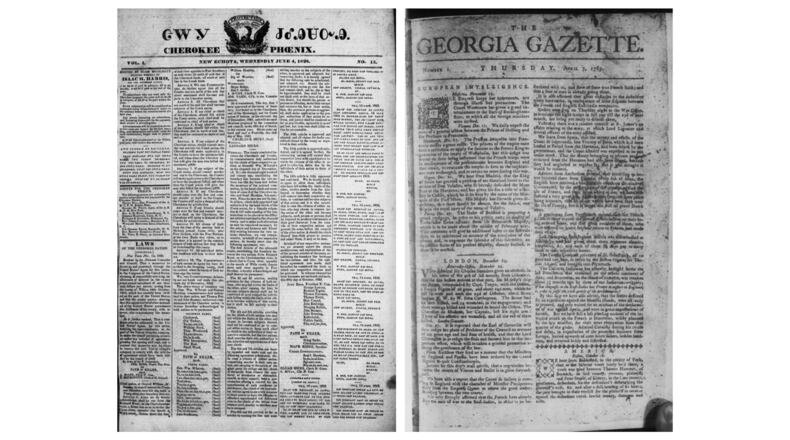Here’s the problem with microfilm: Everybody hates it.
It is cumbersome to use. You must physically load a reel onto a balky machine and laboriously search for the information you desire. Machines break, with few technicians to fix them.
Housed at the University of Georgia, the Digital Library of Georgia has, over the last 70 years, committed 20 million newspaper pages to plastic reels, from publications as old as the Revolutionary War.
But that will end next year.
“We’re going to stop microfilming at the end of this fiscal year, and the reason we’re doing that is nobody likes using microfilm,” said Sheila McAlister, director of the Digital Library of Georgia.
Instead the DLG will focus on scanning print products directly into digital form, and collecting “born-digital” files from newspapers that publish online.
A new $302,070 grant from the National Endowment for the Humanities will help. The money will go toward digitizing 100,000 pages of newspapers published during the Jim Crow and early civil rights eras. This will raise to 420,000 the number of Georgia pages digitized through the NEH National Digital Newspaper Program, all accessible through the Galileo system.
All told, the DLG has posted 3.1 million newspaper pages online, though that’s a drop in the bucket compared to the pages that are trapped in microfilm and yet to be scanned.
The DLG has put other historic accounts online, including the personal papers of such political figures as Richard B. Russell and Herman Talmadge. But newspapers, said McAlister, offer a unique view of the lives of Georgians.
“Newspapers really describe a community in a way that those community members describe themselves,” she said. “You’re reading what’s important to them, and you’re not reading what’s not important to them.”
Consequently, the project will sample newspapers from Bainbridge to Augusta. They will upload stories from Black-owned newspapers such as the Atlanta Inquirer and from publications such as The Statesman, edited by segregationist Eugene Talmadge.
While Athens works to preserve Georgia’s written history, Atlanta is tasked with its visual record.
Credit: Alyssa Pointer
Credit: Alyssa Pointer
At Georgia State University there are 10 million photographs looking for a home. Eight million of those are from a collection donated by The Atlanta-Journal Constitution that extends back to the 19th century.
Millions more are from the collections of commercial photographers, from the archives of alternative publications such as The Great Speckled Bird and Creative Loafing and from amateur photographers such as David Lennox, and many other sources.
These photos currently reside in a leaky room under the Urban Life building on the GSU campus. Georgia State has secured a better keep, under a parking deck that once serviced the Trust Company of Georgia.
During its banking days the 10,000-square-foot underground bunker was a storehouse for canceled checks, complete with a Mosler vault door. Now owned by GSU, the room will be outfitted with a walk-in freezer/refrigerator (for negatives) and a new HVAC system, courtesy of a $344,315 grant from NEH.
Credit: Georgia State University
Credit: Georgia State University
Those improvements are the first step in a project that will cost about $3.5 million, according to Christina Zamon, head of special collections and archives.
Georgia State is currently seeking private donors to make up the difference.
It may seem old-fashioned to be building a huge library to warehouse negatives and prints. Why not digitize everything?
The answer is it takes time, not only to digitize the images, but to enter metadata. And time is the sworn enemy of plastic negatives and delicate emulsions. “At one point the Library of Congress said if they were to digitize everything it would take over a thousand years,” said Zamon. Her collection would take at least a hundred.
In the meantime, this priceless visual history needs to reside in a cool dry place, to slow down the process of disintegration.
GSU has been planning to retrofit the old vault for several years. The NEH grant means that “the clock is ticking,” said Zamon.
“Ideally we’ll have construction documents this fall,” she said. “The (NEH) money hits the account in October.” Construction, she said, should start in February and “even with a few bumps in the road,” they will be moving more than a century’s worth of photographs into the space in 2025.
About the Author







